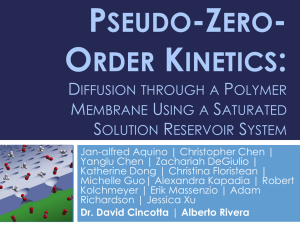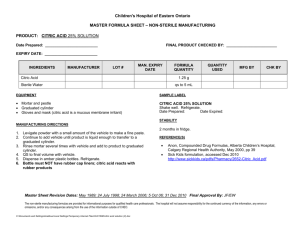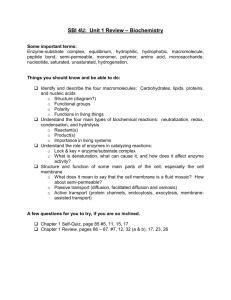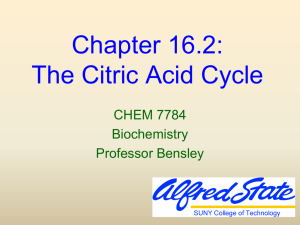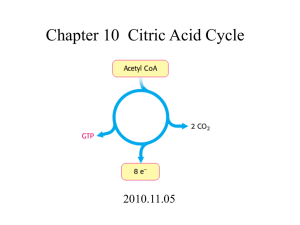pseudo-zero-order kinetics across a polymer
advertisement
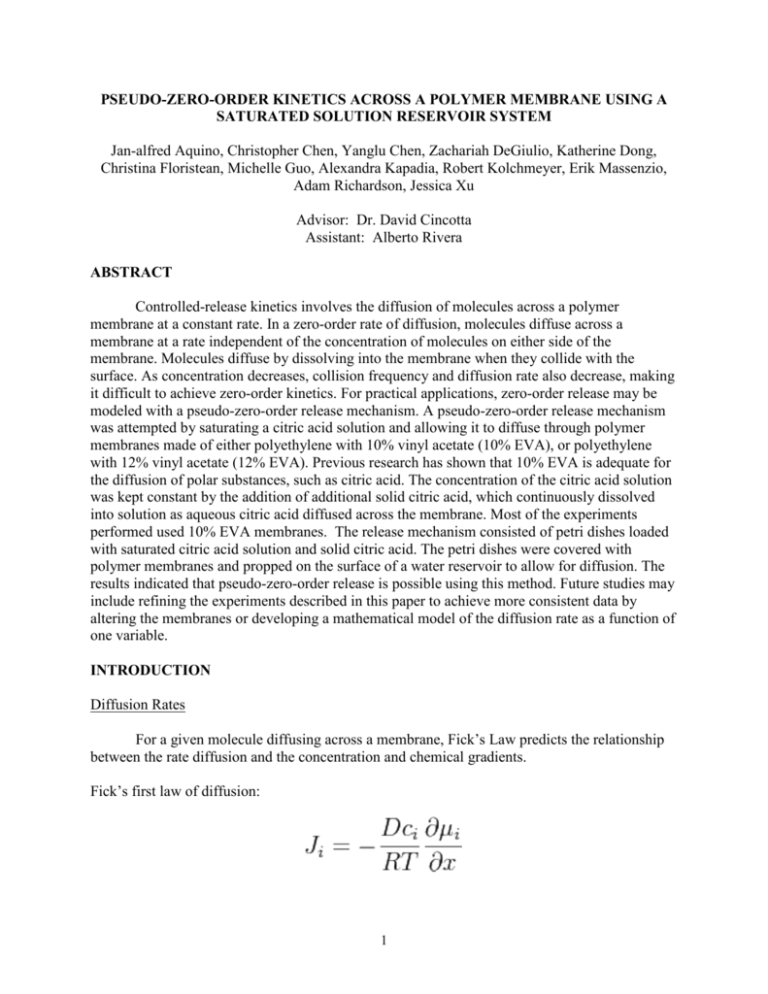
PSEUDO-ZERO-ORDER KINETICS ACROSS A POLYMER MEMBRANE USING A SATURATED SOLUTION RESERVOIR SYSTEM Jan-alfred Aquino, Christopher Chen, Yanglu Chen, Zachariah DeGiulio, Katherine Dong, Christina Floristean, Michelle Guo, Alexandra Kapadia, Robert Kolchmeyer, Erik Massenzio, Adam Richardson, Jessica Xu Advisor: Dr. David Cincotta Assistant: Alberto Rivera ABSTRACT Controlled-release kinetics involves the diffusion of molecules across a polymer membrane at a constant rate. In a zero-order rate of diffusion, molecules diffuse across a membrane at a rate independent of the concentration of molecules on either side of the membrane. Molecules diffuse by dissolving into the membrane when they collide with the surface. As concentration decreases, collision frequency and diffusion rate also decrease, making it difficult to achieve zero-order kinetics. For practical applications, zero-order release may be modeled with a pseudo-zero-order release mechanism. A pseudo-zero-order release mechanism was attempted by saturating a citric acid solution and allowing it to diffuse through polymer membranes made of either polyethylene with 10% vinyl acetate (10% EVA), or polyethylene with 12% vinyl acetate (12% EVA). Previous research has shown that 10% EVA is adequate for the diffusion of polar substances, such as citric acid. The concentration of the citric acid solution was kept constant by the addition of additional solid citric acid, which continuously dissolved into solution as aqueous citric acid diffused across the membrane. Most of the experiments performed used 10% EVA membranes. The release mechanism consisted of petri dishes loaded with saturated citric acid solution and solid citric acid. The petri dishes were covered with polymer membranes and propped on the surface of a water reservoir to allow for diffusion. The results indicated that pseudo-zero-order release is possible using this method. Future studies may include refining the experiments described in this paper to achieve more consistent data by altering the membranes or developing a mathematical model of the diffusion rate as a function of one variable. INTRODUCTION Diffusion Rates For a given molecule diffusing across a membrane, Fick’s Law predicts the relationship between the rate diffusion and the concentration and chemical gradients. Fick’s first law of diffusion: 1 where J is the rate, c represents concentration, D and R are constants, and dµ/dx represents the change in chemical potential with respect to surface area in one dimension. Assuming the change in chemical potential, which is proportional to the concentration gradient, is constant over the surface, this model predicts a diffusion rate proportional to the concentration, resulting in a firstorder rate of diffusion over time. A diffusion rate that is independent of concentration is zeroorder (1). Very few zero-order diffusion processes exist in nature, and most known zero-order processes are actually pseudo-zero-order, in which diffusion occurs at a constant rate, even though the rate is still dependent on concentration (2). Controlled-Release Controlled-release technology releases chemicals into an environment at a constant rate. Without the use of controlled-release, chemicals must be administered at repeated intervals in order to maintain the effective concentration. The application of zero-order or pseudo-zero-order release is becoming increasingly important in the field of medicine due to the advantages it provides over first-order release (3). Two types of drug delivery systems are immediate release and extended release. Immediate release systems release the drug directly after administration. As a result, the time period in which the chemical concentration is in the therapeutic range of the drug can be quite short (4). Frequent dosing is required, leading to an increased probability of adverse effects (Fig. 1). By contrast, extended release systems allow for the drug to be released over prolonged time periods. An example of such a system is a slow drip pump in a hospital. Zero-order or pseudo-zero order kinetics allows for passive extended release systems. This can be achieved primarily through the use of polymers, which can coat granules or tablets. The polymer membrane system used in the experiments is a macroscopic version of such an extended release system. Figure 1: Graphical Representation of the Concentration of Substance over Time With Various Release Mechanisms. The goal of controlled release systems is to maintain a constant and effective dosage of drug or other substance over extended periods of time to reduce the need for frequent doses and their accompanying side effects. Polymer Membrane The polymers used contained a combination of dense, linear, crystalline regions and amorphous regions (Fig. 2). Amorphous regions more easily allow diffusion than crystalline regions. Ethylene-vinyl acetate (EVA), whose structure is shown in Figure 3, is a flexible elastomer that is mostly made of ethylene (C2H4) and vinyl acetate groups (CH3COOCH=CH2). 2 As vinyl acetate (VA) content increases, the random placement of VA groups disrupts the linear rigidity of the polymer and decreases its crystallinity. With 40-50% VA content, the polymer becomes completely amorphous (5). Additionally, increased VA content results in increased polarity of the polymer (5). Considering the high polarity of our solute, citric acid, the addition of vinyl acetate would increase permeability and encourage diffusion of our solute across the membrane. For this experiment, the main polymer membrane used was 10% ethylene-vinyl acetate, a copolymer that consists of 10% vinyl acetate and 90% ethylene by weight. Trials with 12% EVA were additionally performed, with the expectation that the effects of vinyl acetate would be more pronounced. Figure 2: Crystalline and Amorphous Regions of Polymer. Molecules can more easily diffuse through the amorphous regions rather than the linear rigidity of crystalline regions. Figure 3: Molecular Structure of Ethylene-Vinyl Acetate. The left formula represents ethylene, which composes the bulk of EVA polymer. The right formula represents a vinyl acetate group that is randomly placed in the polymer, reducing crystallinity of the membrane.(6) Citric Acid Citric acid was determined to be the best candidate for this experiment after a series of trials using citric acid, maleic acid, sodium chloride were conducted. It was also chosen because it is a solid at room temperature and it is highly soluble in water (73g/100mL at 20 °C). Citric acid is a weak acid, reducing the risk of acidic degradation of the polymer membrane. Although citric acid is not considered large compared to other organic acids, it is larger than water, giving it a disadvantage in diffusion across the membrane (Fig. 4). In experimental trials however, citric acid ultimately proved able to diffuse due to the affinity between its own polarity and the polarity of the EVA. As a triprotic acid, citric acid may lose up to three hydrogen ions in water, with each successive hydrogen being less easily lost than the previous. This is exemplified in the 3 distribution of citric acid ions in Figure 5, as well as citric acid’s pKa values: pKa1 = 3.13; pKa2 = 4.76; pKa3 = 6.40 (6). Figure 4: Molecular Structure of Citric Acid. The molecular formula of citric acid is C6H8O7 and its molar mass is 192.12g/mole (7). Figure 5: Citric Acid Speciation. At a certain pH, not all citric acid molecules lose the same number of hydrogen ions. Because of citric acid’s polyprotic nature, it is not easy to determine the concentration of citric acid that diffused through the membrane given only the concentration of H+ ions (pH). (9) pH pH was selected as a data parameter because it was the most convenient and efficient method of evaluating concentration. Since citric acid was chosen as the compound to be used for experimentation and has a pH lower than that of water, measuring the pH of the basin water can accurately document the changes in concentration of H+ ions, and by extension, of citric acid. Moreover, the pH probe would be able to continuously make measurements over extended periods of time. Previous Research This research project is founded upon the progress of two previous groups in 2010 and 2011. The 2010 group confirmed that polarity has an effect on membrane diffusion, while the 2011 group demonstrated that a combination of capsules and membranes could achieve zeroorder kinetics. In 2010, the organic liquid substances ethyl acetate, hexane, and 2-pentanol were administered to petri dishes covered with polyethylene, 10% EVA, and 12% EVA membranes, and heat was applied in order to facilitate the diffusion of vapors through the membranes. They explored the effect of polarity on the rate of diffusion of molecules across the membrane. The 4 2011 group focused on creating a functional model of zero-order diffusion to simulate a pharmaceutical technology. Capsule reservoirs were used to determine that the diffusion of a solute across a membrane would represent a more useful simulation of the real-world applications of zero-order diffusion. While the previous groups used liquids and gases, this project instead uses solids and aqueous solutions, thus developing a new area of research. HYPOTHESIS Pseudo-zero-order release can be achieved by saturating a solution of citric acid, placing the saturated solution into a petri dish with solid citric acid, and allowing the solution in the petri dish to diffuse into a water basin through a polymer membrane. It is predicted that the solid citric acid will continuously restore the solution to a saturated state as aqueous citric acid diffuses through the polymer membrane. Since the rate of diffusion is dependent on the concentration gradient of the citric acid, a constant concentration of citric acid will allow for a constant rate of diffusion, which defines pseudo-zero-order release. As the citric acid will be diffusing into a relatively large and continuously stirred basin of water, the concentration of citric acid outside of the membrane should be negligible in its effects on the rate of diffusion. METHODS AND MATERIALS Experimental Design In order to achieve the environment necessary to produce pseudo-zero-order diffusion, the system required a membrane that provided a significant surface area to allow for maximum diffusion in the alotted time. The circular petri dish offered a flat surface with both uniform and considerable surface area. A glass tray acted as the basin into which the saturated solution diffused. A polymer membrane of either 10% EVA or 12% EVA was held taut over the open top of a petri dish. The petri dish was prepared with two layers of Parafilm on both sides of the membrane. On the outer layer of Parafilm, a rubber band was wrapped around the petri dish to ensure that the membrane would retain its integrity in the water. The petri dish was placed, membrane-side down, in the reservoir atop three 5-gauge corks (Fig. 6). 5 Figure 6: The Setup. The petri dish is placed membrane down in a reservoir, with corks supporting it. Some setups required an additional petri dish on the bottom of the reservoir to elevate some of the membranes and increase the volume of water that could be added to the reservoir. The water level outside the petri dish was filled to the same level as the solution inside the petri dish. A weight was placed on top of the petri dish to prevent corks from floating to the top. Contact between the membrane and the water was maximized. A pH probe was placed in the water outside the petri dish. It recorded the pH of the solution outside the membrane every 6 minutes for 68 hours. The entire basin and its contents were placed on a hot plate with only the ‘stir’ setting on. To create the saturated solution, solute (citric acid) was gradually added to 200mL of deionized water; the solution was stirred continuously. It was heated to ensure that the maximum amount of solute would dissolve. The solution was then cooled to room temperature and a small amount of citric acid precipitated. At this point, the solution was determined to be saturated and was filtered to remove any excess solute. In 8 petri dishes, 5 grams of citric acid were added to the saturated solution to keep the rate of diffusion constant. As solute diffused out of the petri dish, more solid in the petri dish would dissolve, sustaining a constant concentration of citric acid inside the petri dish. The setups were divided between two membranes: 12% EVA and 10% EVA. The controls for the experiment were petri dishes with 10% EVA membranes containing water. This was used as a control to determine whether changes in the pH of the basin water was significant, which altered the calculation of the citric acid concentration. In the first experimental trial with saturated solution, 10 g of additional solid was added to 3 petri dishes along with the appropriate control. This trial ran for 20 hours, and data were 6 collected every 6 minutes. This setup differed from the one described above, in that petri dish covers were not used to elevate the membranes. Additionally, the containers were sealed differently; later iterations had more parafilm wrapped around the petri dishes to make them more watertight. The final experiment was performed to verify the results from a previous experiment, as well as to account for any discrepancies between setups. This trial ran for 20 hours, and data were collected every 6 minutes. The final experiment included six trials utilizing the 12% EVA membrane, with 3 petri dishes including 2 grams of added solid, and 3 petri dishes including solely the saturated solution. It was noted that the fume hoods had a negative pressure which accelerated the evaporation of some reservoir water. As a result, all the setups of the final experiment were placed outside of the fume hood with cling wrap covering the reservoir. Alterations in setup were taken to reduce confounding variables which may have affected results. Evaluation Techniques The purpose of the pH measurements was to quantitatively determine the concentration of the solution, and thus how much solution diffused through the membrane. Using a pH probe was the best option in recording data continuously over a long stretch of time. The polyprotic nature of citric acid required that a standardization curve be used in order to fully interpret the data (Fig. 7). Although it is possible to convert pH to concentration using Ka values, due to the inaccuracy of instruments and complicated conversions, the curve was created in order to promote accuracy and uniformity of all measurements. Serial dilutions with concentrations ranging from 1M to 1x10-7 M were made, and their pHs were measured multiple times. The calibration graph (Fig. 7) produced a linear equation that converted pH to concentration of citric acid. Figure 7: Standardization Curve of Citric Acid. The pH of several known concentrations of citric acid were measured to create a regression line, a function of concentration and pH. Evaporation Analysis 7 An analysis of the effects of negative pressure inside the fume hood and coverings on petri dishes was performed. Twelve petri dishes were filled with 40 mL deionized water. Three petri dishes were placed in the hood with plastic wrap covering, three petri dishes were placed in the hood without covering, three petri dishes were placed on the counter with plastic wrap covering, and three petri dishes were placed on the counter without covering. After 24 hours, the volumes of water inside the dishes were measured. RESULTS Table 1: Experimental Trials. Four sets of experiments were performed, each using a different set of membranes and different amounts of saturated solution. The petri dish reservoir apparatuses for each experiment were prepared using the same methodology. Experiment # Fig. # # Trials Amount of Saturated Solution Polymer type Additional Solid Experiment 1 Fig. 8 2 trials 20 mL 10% EVA No solid Experiment 2 Fig. 9 2 trials 40 mL 10% EVA 5 grams Experiment 3 Fig. 10 3 trials 40 mL 10% EVA 5 grams Fig. 11 3 trials 40 mL 12% EVA 5 grams Fig. 12 3 trials 30 mL 12% EVA No solid Fig. 13 3 trials 30 mL 12% EVA 2 grams Experiment 4 Experiment 1 The first experiment was designed to choose a reliable substance to use in the saturated solution reservoir system. Petri dishes of NaCl solution, citric acid solution, and maleic acid solution were allowed to diffuse into a reservoir of water through 10% EVA. NaCl solution diffusion showed irregular and sporadic diffusion, and the provided conductivity probe did not include a range large enough for a standardization curve to be developed. pH meters were used for maleic acid and citric acid, and the measured pH was converted to concentration by using the formula [H+] = 10-pH . The irregular diffusion rates of maleic acid led to citric acid as the choice of solute (Fig. 8). 8 Figure 8: Effect of Citric Acid on the pH of the External Water. (pH vs Time) The x-axis represents time in hours, while the y-axis represents pH of the outside water due to the diffusion of citric acid. The red line represents a trial where one petri dish of citric acid covered by 10% EVA was placed in a basin, while the blue line represents a trial where three petri dishes of citric acid were placed in the same basin. The consistent and predictable behavior of citric acid in the preliminary Experiment 1 led to the selection of citric acid as the best candidate for the solute. The pH of the reservoir water decreases in accordance with the logarithmic nature of pH. In later experiments, the standardization curve was used to convert pH curves to graphs of concentration in moles. Experiment 2 Experiment 2 tested a saturated solution reservoir with 5 grams of addition solid citric acid. The linear nature of Experiment 2’s trials (Fig. 9) supports the hypothesis that pseudo-zeroorder release is achievable with added solute to the petri dish. 9 Figure 9: Diffusion of Citric Acid across a 10% EVA Membrane (Table 1) The x-axis represents time in hours, while the y-axis represents concentration of citric acid in the basin water in molarity. The two colored lines represent two trials that were set up identically, and the black lines are the linear regression lines or the lines of best fit for the two sets of data, over the time period indicated by the brackets. Information about the linear fit is in the boxes. As citric acid diffused from the petri dish through 10% EVA membrane, the pH was measured in the outside water reservoir and later converted to concentration of citric acid using the standardization curve. The linear nature of the two trials shown supports our hypothesis of achievable pseudo-zero-order release. The variation in slope shows much experimental error, as both setups were believed to be identical. Experiment 3 Experiment 3 improved confidence in the setup’s ability to produce a constant rate of diffusion across the membrane because all graphs produced linear relationships after an initial period of time (Figure 10). The curvature of the first 30 hours is most likely due to saturation of the polymer membrane and the establishment of a steady state gradient. 10 Figure 10: Diffusion of Citric Acid across a 10% EVA Membrane (Table 1). The x-axis represents time in hours, while the y-axis represents concentration of citric acid in the basin water in molarity. The three colored lines represents data from three trials that were set up identically, and the black lines are the linear regression lines for the three sets of data, over the time period indicated by the brackets. Information about the linear fit is in the boxes. To attempt to resolve the variation observed in Experiment 2, three additional trials were made with a similar setup. The rate of diffusion, shown by the slope of the regression line, still varied greatly between the three trials, but the rate was observed to be constant, thus showing pseudo-zero-order release. The data from trial 1 and trial 3 match a linear regression line for about 40 hours, with correlation values of 0.9497 and 0.9741 respectively, supporting the hypothesis and the feasibility of pseudo-zero-order release. The variation in slope and the behavior of the data in the first 20 hours may be a result of uncontrolled sources of error. 11 Figure 11: Diffusion of Citric Acid across a 12% EVA Membrane (Table 1). Similar to Figure 10, in this graph, the x-axis represents time in hours, while the y-axis represents concentration of citric acid in the basin water in molarity. The three colored lines represents data from three trials that were set up identically, and the black lines are the linear regression lines for the three sets of data, over the time period indicated by the brackets. Information about the linear fit is in the boxes. In Experiment 3, membrane material was changed to 12% EVA to determine if the release rate became more controllable. Rate of diffusion remained relatively constant among the three trials, showing an average slope of 24.39 µM/hr. Furthermore, the correlation coefficients were very close to one, with values of 0.9974, 0.9271, and 0.9796 respectively. The three trials appear to be different by constant concentrations, seen in the different y-intercepts of the linear regression lines, but this may be due to differences in the calibration of pH-meters. Overall, the consistent rate of diffusion seen in these trials shows great promise for the feasibility and control of pseudo-zero-order release. Experiment 4 After observing that up to 55% of the water in an uncovered basin in the fume hood evaporated (Table 2), experiment 4 represents the most accurate procedure thus far. These trials produced consistently straight lines; however, the slopes of these lines differ greatly. This trial proves that the experimental procedure and setup produces consistently linear rates. The slopes of these straight lines, however, are inconsistent. For Experiment 5, different size reservoirs were needed for the same type of trial. Thus, the difference in reservoir size was accommodated for by first converting pH into concentration and then converting concentration into moles. 12 Figure 12: Diffusion of Citric Acid across a 12% EVA Membrane (Table 1) The x-axis represents time in hours, while the y-axis represents the amount of citric acid diffused in moles. The three colored lines represents data from three trials that were set up identically, and the black lines are the linear regression lines for the three sets of data, over the time period indicated by the brackets. Information about the linear fit is in the boxes. A saturated solution without additional solid was used as a control to show the effect of adding amounts of solid citric acid to the petri dish. The measured pH was first converted to concentration and then to amount in moles, using the volume of basin water. The three trials performed show much variation in behavior, reducing the applicability of comparison with the other experiments. The oscillating behavior of the graph of amount 1 may indicate an issue with the pH meter, but still shows an upward trend. The relative upward trend is unusual because a non-pseudo-zero-order diffusion was expected, but this may have occurred because the concentration of solution in the petri dishes and the amount of basin water were large, so a small amount of diffusion did not change the ratio of the two values much. 13 Figure 13: Diffusion of Citric Acid across a 12% EVA Membrane (Table 1) The x-axis represents time in hours, while the y-axis represents the amount of citric acid diffused in moles. The three colored lines represents data from three trials that were set up identically, and the black lines are the linear regression lines or the lines of best fit for the three sets of data, over the time period indicated by the brackets. Information about the linear fit is in the boxes. Trials similar to those shown in Figure 11 were performed (Fig. 13). The measured pH was first converted to concentration and then to the amount in moles, using the volume of basin water. Similar to Figures 9 and 10, the rates of diffusion (slope of the best fit line) were relatively constant over time within each trial but varied considerably among the trials. Still, correlation values for linear fit were high in the three trials, again showing pseudo-zero-order diffusion. The data suggests that better control of sources of error may lead to constant diffusion. Table 2. Evaporation Controls. Twelve petri dishes filled with 40 mL of water each were set up as controls to test how placement and covering affected evaporation. The dishes that were covered lost a negligible amount of volume regardless of their placement. It was concluded that the negative pressure within the hoods greatly increased evaporation. This was rectified in the last iteration of the experiment, in which the basins were covered and placed overnight on counter space. Trial 1 Trial 2 Trial 3 Hood, Covered 40.0 mL 40.0 mL 40.0 mL Hood, Uncovered 26.0 mL 26.5 mL 26.0 mL Outside, Covered 40.0 mL 40.0 mL 40.0 mL Outside, Uncovered 38.0 mL 36.0 mL 34.0 mL 14 DISCUSSION Identifying the Appropriate Solute The first step in creating a pseudo-zero-order system was to narrow down the possible compounds to those that would behave most ideally under the proposed conditions. After a 68hour trial using citric acid, maleic acid, and sodium chloride solutions, it was determined that citric acid would be the most suitable solute to use because its results were the most reproducible. Maleic acid exhibited inconsistent data, revealing great variability for one trial and almost no diffusion for the other, while sodium chloride was difficult to monitor due to the inefficiency of measuring conductivity (Fig. 8). Citric acid was the only compound used in later experimentation. Testing the Hypothesis Experiment 2 resolved some issues of the previous experiments. A completely saturated solution was made to create the conditions conducive to achieving a zero-order release. Less solid was added (5 g) in order to conserve citric acid. Trials 1 and 2 of the saturated solutions with additional solute differed in the average rates of diffusion (Fig. 9). The rate for trial 1 was 260.4 μM/h while that for trial 2 was 891.7 μM/h, a 3.42-fold difference in rates. This change may have been caused by the inaccuracy of the pH meters, however further experimentation is necessary to determine the sources of inaccuracy between trials with identical setups. Experiment 3 was run to minimize errors and to obtain a constant rate. Following the experiments, the probes were placed in buffers to test their accuracy, and the inaccuracy of the instruments was recorded. Also, the solutions inside the dishes were vigorously agitated to ensure that less solid attached to the top of the petri dish. This experiment ran the diffusion of citric acid across different membranes, namely 10% EVA and 12% EVA. The results again identified strong inconsistencies with the trials of 10% EVA (Fig. 10). The first and third trials established a strong linear correlation (R-value of 0.9741 and 0.9497, respectively), but a very weak correlation for the second trial (R-value of 0.5962). The rates of diffusion in the 10% EVA also varied by several orders of magnitude. The rates for trials 1 to 3, respectively, were 160.1 μM/h, 6.303 μM/h, and 41.27 μM/h. However, the trials in the 12% EVA exhibited behavior for pseudo-zero-order kinetics (Fig. 11). Those trials all exhibited strong linear correlation, with Rvalues of 0.9974, 0.9271, and 0.9796, respectively. The observed diffusion rates were also relatively unvaried, exhibiting rates of 250.7 μM/h, 272.0 μM/h, and 209.0 μM/h. The graphs varied considerably in the first 20-25 hours to adjust for the time that citric acid needed to permeate the membrane initially. Beyond that time period, the rate of diffusion in the 12% EVA was relatively constant for all trials. The fact that citric acid’s ability to permeate the 12% EVA was considerably greater than its ability to permeate the 10% EVA can be explained by differences in polarity and amorphousness in conjunction with citric acid’s own polarity. Verification The last experiment, experiment 4, attempted to verify past results. Three trials of citric acid saturated solutions were run in 12% EVA (Fig. 12). Three trials of saturated solutions with 2 15 g extra solute were also run in 12% EVA (Fig. 13). Although the previous experiment revealed the possibility of consistent rate of diffusion of citric acid in 12% EVA, the results of this experiment proved otherwise. The trials with only the saturated solution revealed oscillating data about a line in trial 1 (R-value 0.7385), almost no change in concentration in trial 2 (R-value 0.5512), and a strong linear relationship for trial 3 (R-value 0.9507). The diffusion rates for trials 1 to 3 were 304.9, 0.4860, 51.94 µmol/h. The trials with saturated solution and extra solid (2 g) showed that reproducible rate was not reached. Trial 1 yielded a linear correlation value of 0.9845 and a rate of 311.1 µmol/h; trial 2 yielded a linear correlation R-value of 0.8859 and a rate of 5.012 µmol/h; trial 3 yielded an R-value of 0.9123 and a rate of 27.46 µmol/h. The Rvalues for linear correlation remained high, strengthening the probability of having pseudo-zeroorder kinetics. However, the rates varied by a considerable amount (over 62-1 ratio for the rates of Trial 1 to Trial 2). The deviations for trials 2 and 3 may be due to experimental error, since the rate of diffusion in trial 1 corresponds to the rates observed in experiment 3. However, this cannot be affirmed and it can only be said that constant rate of diffusion was not achieved. Sources of Error There were many potential sources of error due to the novelty of the experimental procedure. These errors include inaccuracy of pH probes, evaporation of the liquid in the reservoirs, leakage from the petri dishes, uneven contact between the solution and the membrane, the ratio of the volume of water in the petri dish to the volume of water in the basins, the placement of probes in relation to the petri dish between trials, the reuse of some membranes, human skin oil affecting the membrane, and the blocking of the membrane by extra solid resting on the membrane. CONCLUSION In general, it was observed that the apparatuses exhibited pseudo-zero-order kinetics. While consistent rates were never achieved, results do indicate strong linear correlations, and thus, pseudo-zero-order kinetics. The system developed proved to be simple, yet effective. The method is, however, not without flaws. It was difficult to account for all variables that could have affected the results, although most of these variables can be controlled for with more experimentation. Suggestions for further investigation include altering aspects of experimental design. The unreliability of the pH probes contributed significant error; an alternate method for measuring concentration could more efficiently produce dependable results. In addition, a solute with a lower solubility could be used, since a relatively large mass of citric acid was required to create a saturated solution. In order to optimally utilize time, energy, and resources, future studies should look into a more systematic manner with which the saturation point could be attained. Furthermore, studying how solutions and semipermeable membranes can be used in pseudo-zero-order kinetics is essential to creating new technologies. For instance, controlledrelease enables drug delivery systems to operate efficiently for extended periods of time. One example of the commercial usage of a solution-based delivery is the PerioChip. This controlledrelease system delivers chlorhexidine through a biodegradable membrane to treat periodontal 16 disease (10). Future models for pseudo-zero-order kinetics can explore the usage of biodegradable membranes. Additionally, membrane permeability, and thus kinetic release, can be altered by the addition of plasticizers such as phthalates and tetra ethyl citrate (11). Pseudozero-order diffusion drives drug transport in the hydroxyethyl methacrylate conjunctival insert, a polymer which delivers cyclosporine A to relieve dry eyes (12). Rather than storing the drug in a separate compartment, however, cyclosporine A is embedded in the polymer itself (12). Further research for this approach would investigate the effects of binding between drug and polymer based on their respective properties. Using saturated solutions with additional solid proved to be a novel idea that was useful in a variety of realistic applications. With future work on this project, more practical applications can be postulated and tested. REFERENCES 1. Prisciandaro M. and Pepe F. Absorption with zero and Pseudo-Zero order chemical reaction. The Canadian Journal of Chemical Engineering; (2006) [Internet] [accessed July 29, 2011] 362 – 368p. Available from : http://onlinelibrary.wiley.com/doi/10.1002/cjce.5450750212/abstract 2. Nic M., Jirat J., Kosata B. Compendi of Chemical Terminology. IUPAC Goldbook; (2006).[Internet] [ accessed July 27, 2012]. Available from : http://goldbook.iupac.org/P04937.html 3. Blackmond DG., Hodnett NS., Lloyd-Jones GC., Mechanistic Implications of Pseudo Zero Order Kinetics in Kinetic Resolutions. JACS Communications; (2006). [Internet] [accessed July 29, 2011] 7450 - 7451p. Available from : http://pubs.acs.org/doi/pdfplus/10.1021/ja062173f 4. Jones D. FASTtrack: Pharmaceutics: Dosage Form and Design. London: Pharmaceutical Press; (2008). [Internet] [accessed 2012] Available from : http://www.pharmpress.com/files/docs/FT_Pharmaceutics_Drug_Delivery_sample.pdf 5. Basic Property of EVA Resin. SNE Research; (2006) [Internet] [accessed July 26, 2012] Available from : http://www.sneresearch.com/eng/info/show.php?c_id=4938&pg=6&s_sort=&sub_cat=& s_type=&s_word= 6. Drabczyk K., Panek Piotr. A Comparative Study of EVA with and without thermal history for different lamination process parameters. Material Sciences and Engineering: B; (2011). [Internet] [accessed July 29, 2012]. Available from : http://www.sciencedirect.com/science/article/pii/S0921510712002541 7. Ionization Constants of Heteroatom Organic Acids. Michigan State University. [Internet] [accessed July 26, 2012] Available from : http://www2.chemistry.msu.edu/faculty/reusch/VirtTxtJml/acidity2.htm 8. Material Safety Data Sheet - Citric Acid. Science Lab. [Internet] [accessed July 24, 2012] Available from : http://www.sciencelab.com/msds.php?msdsId=9923495 9. Krishnan KA., Sreejalekshmi KG., Varghese S. Adsorptive Retention of Citric Acid Onto Activated Carbon Prepared From Havea Braziliansis Sawdust: Kinetic and Isotherm Overview. Desalination; (2010). [Internet] [accessed July 30, 2012] 46 - 52p. Available from : http://www.sciencedirect.com/science/article/pii/S001191641000144X 17 10. Periodontics: Controlled release delivery system. British Dental Journal; (2003). [Internet] [accessed July 30, 2012] 195 - 224p. Available from : http://www.nature.com/bdj/journal/v195/n4/full/4810497a.html 11. Controlled release of triprolidine using ethylene-vinyl acetate membrane and matrix systems. European Journal Pharmaceutics and Biopharmaceutics. (2002) [Internet] [accessed 2012] 201 - 206p. Available from : http://www.sciencedirect.com.ezproxy.drew.edu/science/article/pii/S0939641102000516 12. Gupta C., Chauhan A.Drug transport in HEMA conjuctival inserts containing precipitated drug particles.Journal of Colloid and Interface Science ; (2010). [Internet] [accessed July 30, 2012] 31 - 42p. Available from : http://www.sciencedirect.com.ezproxy.drew.edu/science/article/pii/S0021979710003267 18
